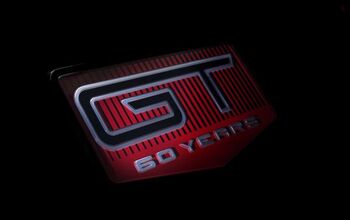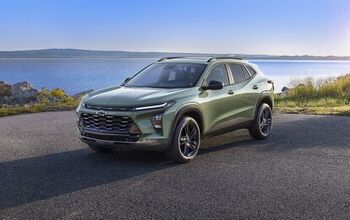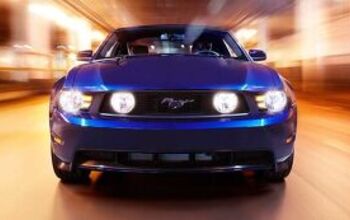Review: 2011 Ford Mustang GT 5.0 Take Two
After driving the Chevrolet Camaro SS for a couple of days, and enjoying the experience much less than I expected to, I began to question my expectations. Perhaps having the Lexus IS-F for a week had unfairly put the Chevrolet in a bad light? After all, the IS-F was twice the price and a Lexus, so of course the Detroit Oshawa, Ontario iron seemed coarse in comparison. The obvious test: a 2011 Mustang GT 5.0.
Back in the early 1980s, when my pre-license self lusted after both cars, the Mustang wasn’t as sexy as the Camaro. And it still isn’t. The Ford has never been as low to the ground or as sleek, and
even after the 2010 nip-tuck excessive rear overhang mucks up the car’s proportions. But even if the car isn’t beautiful, it’s handsome, and it’s clearly a Mustang. Which cuts both ways. As with a Harley-Davidson, you either want one or you don’t.
The 2010 refresh did take the Mustang’s interior up a notch or two. Though still not “premium” (despite the trim level), there are enough soft-touch bits assembled with sufficient precision to not seem far beneath the mid-thirties price tag. Perhaps to enforce one of Baruth’s rules, the steering wheel’s thick plastic spokes continue all the way to the outer edge of the rim. You won’t be resting a thumb. But neither will you be comfortably gripping the wheel at 9 and 3.
Another consistent difference since at least the early 1980s: you sit much higher relative to the instrument panel in the Mustang. Perhaps even a little too high—I’m far from tall, but would never use the power height adjustment in this car. This driving position detracts from the car’s perceived sportiness, but greatly aids forward visibility and shrinks the car’s perceived size. In the past the Mustang has sometimes had a more usable rear seat than the Camaro. This time around they’re about equally useless. The Ford’s
trunk is a little larger, though, and its opening isn’t constricted.
For at least the last quarter-century the Mustang has always been about its engine, with the rest of the car just along for the ride. The big news for 2011 is of course the return of the 5.0-liter V8. Which is actually 5.0 liters (and not 4.942) this time around. I remember the first 5.0. I actually came close to buying that 5.0 in the mid-80s (but couldn’t have lived with the handling). This is not that 5.0—it’s so much better. I remember salivating when Ford extracted 200 horsepower from the old engine; I even had my father buy a Lincoln Mark VII LSC with one under the hood. The new 5.0 is good for 412.
I frankly don’t care which car is quickest in the quarter. I care about how the powertrain sounds and feels when driven as aggressively as public roads permit. Because that’s where I drive. I cringed when taking the Camaro near the redline. In contrast, runs to 7,000 rpm in the 2011 Mustang GT are pure joy. Though the engine retains some of the traditional American V8 rumble and roar—for the consituency—it’s a thoroughly up-to-date DOHC design, and when opened up it sounds and feels like one. As Baruth attested, big buck German V8s have little or nothing on this powerplant. It’s thrillingly powerful, surprisingly smooth, and the noise you hear you
want to hear. And when you don’t want to hear it, it’s quieter.
Ford designed the variable intake and valvetrain for a broad powerband. Compared to the Camaro, the rush starts lower and runs higher—there are nearly another 1,000 rpm between the torque peak and the power peak. The dyno charts might suggest otherwise, but the Ford V8 feels punchier at low rpm. The Mustang’s lower curb weight—3,605 vs. 3,860 lbs.—contributes.
Though still not among the best, the Mustang’s shifter (finally attached to a six-speed manual) is considerably slicker than that in the Camaro. Smooth shifts occur by default. Instead, the drivetrain’s weak link is at the far end. In a severe challenge to logic, Ford has installed a first-rate variable-everything DOHC V8 into a car with a live rear axle. Ford claims they ditched the independent rear suspension with which the platform was originally endowed (in Lincoln LS form) for cost reasons. But this is a $35,000+ car. Mustang buyers are apparently willing and able to spend $495 for shiny wheels. They wouldn’t spend a similar amount for a rear suspension capable of keeping cool under duress? Perhaps $500 would be a deal killer for those buying the base V6 with nothing else. But Ford has offered IRS as an alternative in the past, and on a platform not originally designed for one.
There are no shortage of apologists for the live rear axle. I don’t doubt that it comports itself just fine on the track. But, as I said, I don’t do my driving on a track. I drive on Michigan roads. I can dodge the potholes, but the lumpiness is all over. Lay the power down on wavy pavement, and the rear end wants to go every direction but straight and level. The sensation is not unlike that in an overpowered front-wheel-drive car, just with the drunken dancing happening at the other end. The untoward motions aren’t hard to control, but confidence is not inspired. In contrast, the Camaro’s far more balanced and composed chassis feels like it could handle another few hundred horsepower without breaking a sweat.
One caveat: I drove a Mustang with the base, 18-inch wheels (and yet also with the optional 3.73 rear end). Order the 19s and Ford throws in a front strut tower brace. The two together no doubt improve the handling and steering feel, but likely do little or nothing to chill out the rear end. The standard brakes are sufficient for off-track driving in the flatlands. For the track or the hills, or just to know it’s there, get the Baruth-inspired (but not Baruth-approved) Brembo Package.
Even with the live axle, the Mustang does have some clear advantages over the Camaro in the handling department. Its steering is a little more communicative and feels much more responsive and agile. It’s a slightly smaller car, and between the driving position and this steering feels like a much smaller car. It’s more lively—in good ways as well as bad. To put things in the simplest terms—and I flat out forgot this word when writing my Camaro review—the Mustang is more fun.
The Mustang doesn’t ride as smoothly as the Camaro, but it’s still far from punishing. Detroit has figured out how to improve handling without killing the ride. Now it’s the turn of some Asian manufacturers.
Delving a bit further into my past, my friends and I watched Gilligan’s Island nearly every day after school. I’ve never seen the appeal of Ginger. It’s always been Mary Ann for me. If you lean the same way, then you’ll prefer the Mustang over the Camaro. It doesn’t have the flashy concept car looks, but it comes across as a much better fit for real life, while still being attractive. It’s also more fun. Remember Ginger smiling? I don’t either. Bonus: aside from the rear suspension, the Mustang is also much more refined. For once the usual trade-off between refinement and driving enjoyment doesn’t apply.
Yes, Sajeev advised people to wait until Ford adds direct injection, which should add 20-30 horsepower, bump the EPA ratings a digit or two, and quicken responses. But compared to the differences between last year’s 4.6-liter V8 and the new 5.0, these are hardly worth mentioning, much less waiting for. An independent rear suspension would be a different story, but none is even rumored. The time to tell people to wait was last year.
Frank Cianciolo, an excellent salesperson at Avis Ford in Southfield, MI, provided the car for this review. Frank can be reached at 248-226-2555.
Michael Karesh owns and operates TrueDelta, an online source of automotive pricing and reliability data.
Michael Karesh lives in West Bloomfield, Michigan, with his wife and three children. In 2003 he received a Ph.D. from the University of Chicago. While in Chicago he worked at the National Opinion Research Center, a leader in the field of survey research. For his doctoral thesis, he spent a year-and-a-half inside an automaker studying how and how well it understood consumers when developing new products. While pursuing the degree he taught consumer behavior and product development at Oakland University. Since 1999, he has contributed auto reviews to Epinions, where he is currently one of two people in charge of the autos section. Since earning the degree he has continued to care for his children (school, gymnastics, tae-kwan-do...) and write reviews for Epinions and, more recently, The Truth About Cars while developing TrueDelta, a vehicle reliability and price comparison site.
More by Michael Karesh
Latest Car Reviews
Read moreLatest Product Reviews
Read moreRecent Comments
- Rochester I'd rather have a slow-as-mud Plymouth Prowler than this thing. At least the Prowler looked cool.
- Kcflyer Don't understand the appeal of this engine combo at all.
- Dave M. This and the HHR were GM's "retro" failures. Not sure what they were smoking....
- Kcflyer Sorry to see it go. The interior design and color options in particular are rare in the industry
- Wolfwagen Here is my stable. not great not bad I try to do as much as possible. I work for an Aftermarket automotive parts company so I can get most parts at a discount.i try to do as much of my own work as possible. My wife hates that I spend time and money fixing the vehicles but she doesn't want car payments either so...2019 VW Atlas 50K (wife's) Only issues so far were Brakes and normal maintenance.A Bad Cat Converter which was covered and a replacement of the rear bank head gasket which was a manufacturing defect due to improper torquing at the factory. All under warranty2003 Saab 9-5 Arc Wagon (my DD) 116 K picked up used last year. Replaced Struts, brakes, hatch struts, motor mounts, D/S swaybar link, Timing belt, water pump and thermostat Power steering pump Fuel pump, Both Front window regular rollers, Heater core and cabin air filter. Oil and transmission changes. Love the car but Saab/GM packaging is a nightmare.2005 Cadillac Deville (former DD now Son # 1 DD) picked up used 5 years ago with only 47K now 83K Plugs, coils, P/s pump, Water pump, hoses, P/S lines (mechanic job) evap valve, brakes, Front brake calipers and rear brake calipers. Currently has oil pan gasket leak - looking to have a mechanic do that2009 Mini Cooper (Daughters dd)picked up 2 years ago 67K Brakes and thermostat house to clear check engine light2001 Mazda Tribue (Son#2 dd) 106K picked last summer after he severely damaged a 2004 Hyundai accent. Oil changes








































Comments
Join the conversation
I should add that although the gearing is so tall that in top gear the power band only begins at 80mph with plenty of promise for 140, I didn't dare go much over 100mph. With no feel of how much front end float or grip I had, and my hands moving like I was ballancing a dinner plate on each one, I decided the steering of the car was not capable of it. Honda Prelude steering much better. Such a thing never entered my mind.
The 2011 Mustang is definitely a car to respect. Take a look over at http://www.modularfords.com/f259/ and see what some of those guys are running with just a handful of bolt ons!